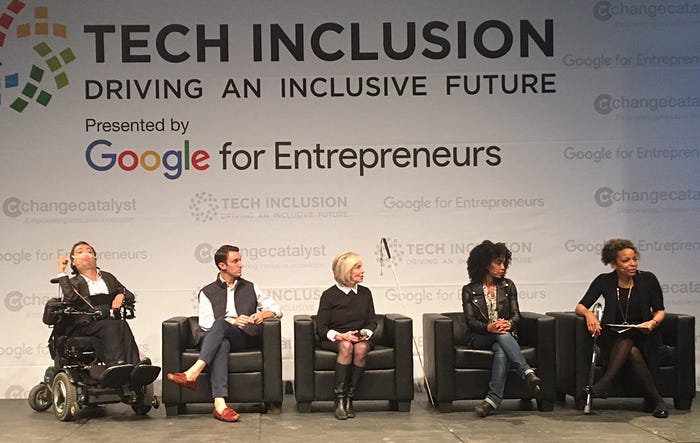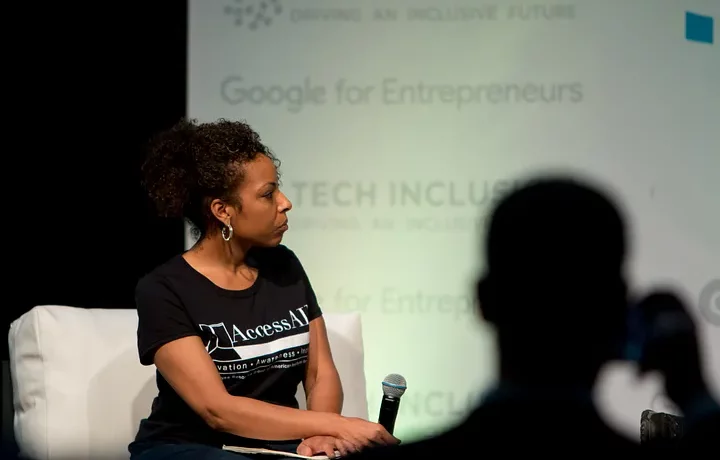Dr. Cynthia Overton recently joined the Kapor Center as our new Director of Tech Workplace Initiatives. She comes to us with years more than a decade of experience in the professional services industry, where she led research, technical assistance, and knowledge translation issues to enhance opportunities for underrepresented populations. I recently interviewed Cynthia about her background, her passions, and the direction she plans to take the Kapor Center.
Q: Hi Cynthia! What led you to the Kapor Center?
I feel like my entire career has led me to this point. I studied learning technologies in grad school and was able to take courses ranging from research methods to software design to social reproduction theory. My dissertation focused on accessible technology and users with disabilities. This topic was personal and important to me because shortly before grad school, I became paralyzed from the waist down and became more dependent on technology to navigate my environment. I walk with a cane now, but still rely on tech to make my life easier.
I’ve always believed that technology can make the world more equitable if we made the effort to channel it appropriately.
After grad school, I joined a professional services nonprofit. When I first started, there were only a handful of Black women with doctorates. We would connect over meals to compare notes about our experiences and try to figure out how to navigate the system. Most of them felt stuck in their career path and ended up leaving after a couple of years in search of better professional opportunities. Even though our group was small, having that network of friends who were similar to me was invaluable.
I can’t tell you the number of times I was the only person of color in a meeting or on a team. Spending time with them became part of my self-care.
Shortly after I joined the nonprofit, I helped launch various diversity initiatives. These grassroots activities eventually evolved to an office of diversity and inclusion with full-time staff. I led two employee resource groups — one focusing on Black staff and the other that focused on disability. I also served on the corporate D&I council.
Later, I became active in the startup community as a content expert for 1776, attending conferences for entrepreneurs, and completing YC’s Startup School. It got to the point where I began spending all of my time outside of my 9 to 5 focused on diversity in the tech ecosystem. I curated all of the information that I came across on an online platform called InclusionClearinghouse.org. Kapor Center research stood out as a force in the field, and I met with Allison Scott, Kapor’s Chief Research Officer, about opportunities to collaborate. That first meeting led to further conversations, and I ended up joining the team late last year and I couldn’t be happier.
Q: Tell us about what you’re working on at the Kapor Center.

My main priority is working with Diversity Advocates. This is a group of more than 900 tech industry professionals who champion for workplace inclusion. With enthusiastic DA members from rapidly growing startups, we’re building a platform to share effective tools and resources, answer sensitive questions and develop a state of the art platform to fuel a sophisticated peer learning community. We’ll host meetups around the U.S. — -and we’re exploring international expansion.
Diversity Advocates is unique in that it serves as an avenue for tech industry professionals across companies to connect with others who share their passion for workplace inclusion. It allows them to share challenges and strategies to achieving equitable workplace practice in a safe space.
Members can find answers to questions that are hard to find in other forums, like:
- What’s the best company size to start Employee Resource Groups? How do you structure them? What are appropriate budgets?
- How do you coach a CEO to answer diversity-related questions at an all hands meeting?
- What are effective responses to employees who feel that diversity programs give unfair advantage to some applicants?
- What are the best tools for taking bias out of the hiring process?
They can also pose questions about important topics that are not as commonly discussed. For example, I recently saw an informative exchange about the spectrum of sexual orientation and identity, and how this translates in the workplace.
Hearing about the experiences of others reminds people that they’re not alone in the issues they’re trying to address.
Information shared about what has and hasn’t worked in a real-life setting helps inform decisions while keeping members motivated. This is especially helpful for members who have transitioned into diversity positions from other roles within their organization.
Q: Why is diversity in tech important to you?
Tech allows companies to scale at a rapid pace. With more and more companies being fueled by technology, every company is becoming a tech company to some degree. Workplace practices that can tap into the talent of a diverse workforce are necessary to have products and services that meet the needs of everyone in society.
Tech needs people from all backgrounds — their experiences inform the right questions to ask and identify the real life problems that need a solution.
And of course, there is the economic aspect. Many people of color, women, people with disabilities, individuals who are LGBTQ+, and others from historically marginalized populations experience unfair workplace treatment that can interfere with upward professional mobility, and the financial rewards that come with it.
Q: What are you most excited about in this new role?
My favorite thing about the Kapor Center is being able to work side-by-side with the people responsible for the Leaky Tech Pipeline report and website. The report offers a framework of the entire scope of tech’s diversity and inclusion problem, and highlights barriers throughout the tech ecosystems, with a focus on pre-K-12 education, higher education, the tech workforce, and entrepreneurship and venture capitalists.
I can’t tell you how many times I’ve cited the Leaky Tech Pipeline when talking about D&I. I also really appreciate that the Kapor Center actively addresses challenges to diversity in tech. In addition to Diversity Advocates, the Kapor Center hosts convenings, engages in community activities, and conducts research and provides practical recommendations–all to advance diversity and inclusion in tech.
My SMASH colleagues run a STEM enrichment and college prep program. Alums go on to get internships and full-time positions throughout tech in startups and large established companies. There is even a SMASH alumnus who works at the Kapor Center and another in a Kapor Capital portfolio company. And then there are those in Kapor Capital, which supports startups that are solving real problems for real people, like a tech-enabled Ombuds for handling complaints of bias and harassment, affordable modular housing, and an educational platform serving more than 12 million of the world’s poorest children in more than 100 languages.
I’m not aware of any other organization that takes such a comprehensive approach to creating an inclusive tech ecosystem that benefits people from all walks of life.


